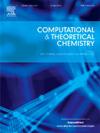DFT – Proposed mechanism of Friedel–Crafts acylation of indole using metal triflate catalysts
IF 3
3区 化学
Q3 CHEMISTRY, PHYSICAL
引用次数: 0
Abstract
The Friedel-Crafts acylation of indole with propionic anhydride using a metal-triflate catalyst is an efficient and environmentally friendly method for synthesizing 3-acylindole, an important pharmaceutical intermediate. Despite its high selectivity for the C-3 position without requiring NH protection, the exact mechanism by which the metal-triflate catalyst promotes regioselective acylation remains unclear. In this study, density functional theory (DFT) calculations were employed to explore acyl substitution at three positions on the indole ring, both in the presence and absence of the catalyst. Two possible mechanisms were proposed: (i) an indirect pathway, where the catalyst forms an electrophilic intermediate (PrOTf) to acylate indole, and (ii) a direct pathway, where indole reacts directly with propionic anhydride at the metal core. The results indicated that the indirect pathway favored N-acylation, while the direct pathway preferred 3-acylindole. Both pathways were observed across several metal triflate catalysts (M = Y, In, Bi, La), in line with experimental data.

求助全文
约1分钟内获得全文
求助全文
来源期刊

Computational and Theoretical Chemistry
CHEMISTRY, PHYSICAL-
CiteScore
4.20
自引率
10.70%
发文量
331
审稿时长
31 days
期刊介绍:
Computational and Theoretical Chemistry publishes high quality, original reports of significance in computational and theoretical chemistry including those that deal with problems of structure, properties, energetics, weak interactions, reaction mechanisms, catalysis, and reaction rates involving atoms, molecules, clusters, surfaces, and bulk matter.
 求助内容:
求助内容: 应助结果提醒方式:
应助结果提醒方式:


